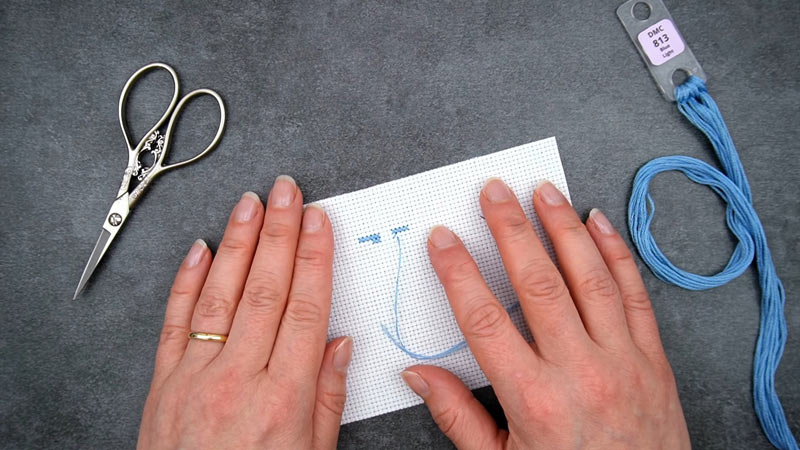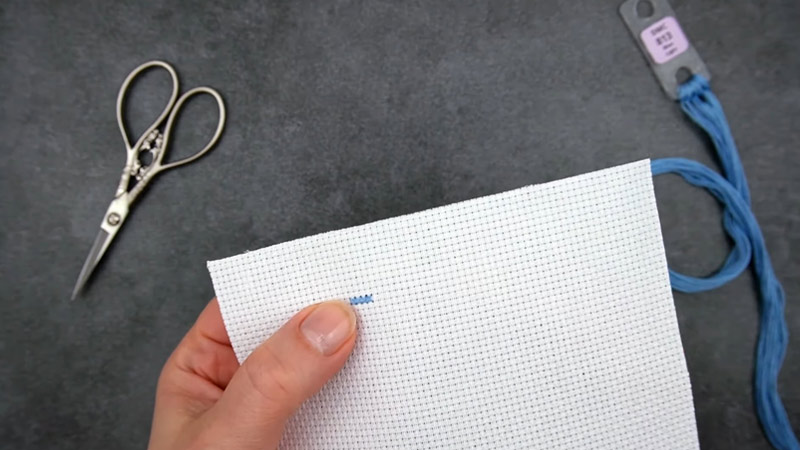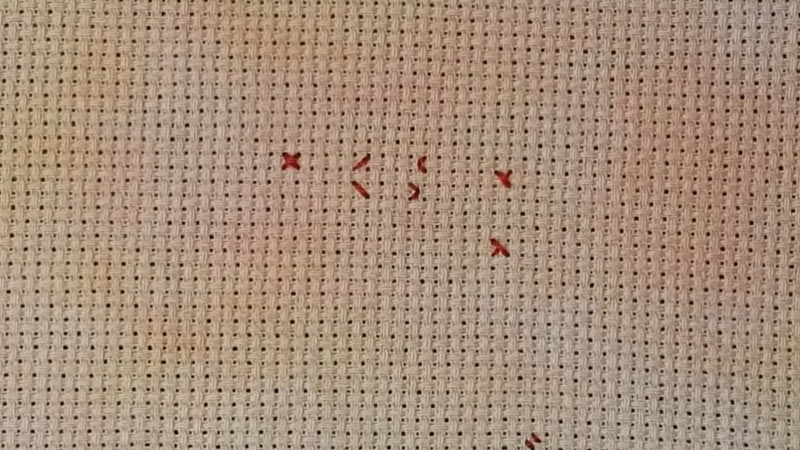Embark on a journey of creativity and tradition as we delve into the enchanting cross-stitch world, guided by the time-honored Danish Method.
Originating from the picturesque landscapes of Denmark, this method not only captures the essence of Nordic craftsmanship but also adds a unique touch to the intricate art of cross-stitching.
This comprehensive guide will unravel the secrets behind the Danish cross-stitching method, exploring its rich history and cultural significance.
From the meticulous selection of materials to the precise techniques that define this approach, each stitch tells a story of craftsmanship passed down through generations.
Whether you’re a seasoned cross-stitch enthusiast or a novice eager to explore the world of needlework, this tutorial promises to be your gateway to mastering the Danish Method.
Join us as we thread through the fabric of Danish tradition, unlocking the beauty and precision of cross-stitching.

Danish Method Of Cross Stitch
Cross stitch, a beloved and timeless craft, has been woven into the cultural fabric of Denmark through the ages.
The Danish Method of Cross Stitch is not merely a technique; it’s a journey through history and tradition, a meticulous dance of needle and thread that has produced some of the most enchanting needlework masterpieces.
The History of Danish Cross Stitch
The origins of Danish cross stitch can be traced back to Denmark’s rural landscapes and cottage industries. It emerged as a form of decorative art, often adorning the interiors of Danish homes with intricate and colorful patterns.
The craft was initially passed down through generations within families and communities, creating a rich tapestry of tradition.
Danish crossstitch is characterized by its emphasis on precision, symmetry, and the use of a limited color palette. Designs often feature geometric patterns, floral motifs, and elements inspired by nature.
This method strongly emphasizes the quality of materials, with artisans selecting the finest fabrics and threads to ensure the longevity of their creations.
Materials and Tools

Gather the essential materials and tools to embark on your Danish cross-stitch journey. Opt for a high-quality cross-stitch fabric with a thread count that suits your project’s scale – finer fabrics for intricate details and coarser ones for larger designs.
Select a palette of embroidery floss in traditional Danish hues, focusing on earthy tones and soft pastels. Invest in quality embroidery needles that match the fabric’s thread count.
The Danish stitching method often involves using a blunt-tipped tapestry needle to ensure smooth, precise stitches without damaging the fabric.
A reliable embroidery hoop will help maintain tension and prevent distortion, enhancing the overall neatness of your finished piece.
Complexity for Beginners
The precision and attention to detail required in the Danish Method can be challenging for beginners. The emphasis on consistent stitch sizes, color choices, and overall neatness may pose a steep learning curve for those new to cross stitch.
Beginners might find it beneficial to start with simpler methods before advancing to the Danish technique.
Mastering the Danish Cross Stitch Method: Step-by-Step Guide

Begin by cutting the fabric to the desired size, leaving a border for framing. Secure the fabric in the embroidery hoop, ensuring it is taut but not overly stretched. Now, follow the steps given below to learn the Danish cross-stitch sewing method:
Selecting Threads
The Danish Method traditionally employs a limited color palette. Choose threads that complement each other and resonate with the nature-inspired hues of traditional Danish designs.
Pattern Selection
Danish crossstitch often features geometric patterns and floral motifs. Select a pattern that aligns with the aesthetic you wish to achieve. Patterns are widely available online or in dedicated cross-stitch pattern books.
Begin with a small knot at the end of the thread, securing it at the back of the fabric. Bring the needle up from the back to the front, starting the first stitch.
Cross Stitch Technique
The Danish Method primarily uses the basic cross stitch. Ensure each stitch is of uniform size and crosses in the same direction. Consistency is key to achieving the characteristic neatness of Danish crossstitch.
Maintaining Tension
Keep an even tension on the thread throughout your stitching. This is where the embroidery hoop proves invaluable, providing stability and ensuring your stitches are uniform.
Finishing Touches
When completing a section or changing colors, secure the thread neatly at the back of the fabric. Take care to avoid bulky knots that might affect the framing or display of your finished piece.
Blocking and Framing
Once your cross-stitch masterpiece is complete, consider blocking the fabric to remove any wrinkles. Choose a high-quality frame that complements your design, protecting and showcasing your work for years to come.
What Are Some Advanced Cross Stitch Techniques?
Once you’ve mastered the basics, delving into advanced cross-stitch techniques can elevate your projects to new heights. Here are some sophisticated techniques to add depth, texture, and complexity to your cross-stitch creations:
Fractional Stitches

Fractional stitches involve creating stitches that are smaller than the typical cross stitch. This technique allows for more intricate details and smoother curves in your designs.
Common fractional stitches include half stitches, quarter stitches, and three-quarter stitches. Mastering these adds a level of refinement to your patterns.
Backstitching
Backstitching is a technique used to outline and define specific elements in your cross-stitch design. It involves stitching over the completed cross stitches using a single strand of embroidery floss, creating a bold and defined border.
This technique is often employed for lettering, fine lines, or emphasizing details in the pattern.
French Knots
Introduce dimension and texture to your cross stitch by incorporating French knots. These small, raised knots can represent details like flower centers or add texture to hair or fur in a design.
While they may take some practice to master, French knots are a delightful way to bring life and intricacy to your needlework.
Specialty Threads
Experiment with various specialty threads to add visual interest to your cross-stitch projects. Metallic threads, variegated threads, or even silk threads can introduce a subtle shimmer or color variation to your designs.
Be mindful of the thread’s thickness, as it may require adjustments to your stitching technique.
Blending Colors
Blend different colors of embroidery floss within a single stitch to create a gradient effect. This technique involves using two or more colors in a needle, allowing them to blend naturally as you stitch.
It’s an advanced method that adds depth and nuance to your cross stitch, particularly useful for portraying subtle changes in shading or capturing the play of light.
Layering Stitches
Create intricate textures by layering stitches on top of each other. Experiment with techniques like the long and short stitch or the satin stitch to add depth and dimension to specific areas of your design.
Layering stitches is particularly effective in creating realistic textures such as fur, feathers, or intricate patterns in clothing.
Hardanger Embroidery
Incorporate Hardanger embroidery elements into your cross stitch for a delicate and lacy effect. Hardanger removes fabric threads to create openwork, often combined with satin stitching and needle weaving.
While this technique requires precision and patience, the result is a beautifully intricate and textured design.
Stitching on Specialty Fabrics
Venture beyond traditional Aida cloth and experiment with specialty fabrics like linen, weave, or even silk gauze.
Each fabric type has its unique texture and characteristics that can enhance the overall appearance of your cross stitch. Keep in mind that different fabrics may require adjustments in your stitching technique.
Blackwork Embroidery
Blackwork is a style of embroidery characterized by intricate geometric patterns stitched in black thread on a white or light-colored fabric. While traditionally done in black, you can experiment with other colors.
The contrast created by the repeating geometric patterns adds sophistication to your cross-stitch projects.
Customizing Patterns
Once you feel confident with advanced techniques, try your hand at designing or customizing cross-stitch patterns. Software tools or graph paper can aid in creating personalized designs, allowing you to infuse your unique style into your needlework.
FAQs
What makes the Danish Cross Stitch Method unique?
The uniqueness of the Danish Method lies in its emphasis on precision, symmetry, and a limited color palette. Designs often draw inspiration from nature, featuring geometric patterns and floral motifs. The method’s distinctive charm is rooted in Danish tradition.
How do I choose the right fabric for Danish crossstitch?
Selecting the right fabric is crucial for a successful Danish cross-stitch project. Opt for a high-quality cross-stitch fabric with a suitable thread count, finer fabrics for intricate details, and coarser ones for larger designs.
What are the essential tools for Danish cross stitch?
To embark on a Danish cross stitch project, gather high-quality embroidery materials. This includes a variety of embroidery floss in traditional Danish hues, a selection of embroidery needles (including a blunt-tipped tapestry needle), and a reliable embroidery hoop to maintain fabric tension.
Are there specific patterns associated with Danish crossstitch?
Danish cross-stitch patterns often feature geometric designs, floral motifs, and nature-inspired elements. These patterns reflect the traditional aesthetics of Danish craftsmanship.
While there are classic designs, artisans also have the freedom to create or adapt patterns according to personal preferences.
Can beginners try the Danish Method of cross-stitch?
Absolutely! The Danish Method is accessible to both beginners and experienced cross-stitch enthusiasts. It provides a structured approach to mastering the craft, and the emphasis on precision can be a valuable learning experience.
Conclusion
As we reach the final stitches of our Danish cross-stitch journey, it’s evident that the Danish Method produces stunning works of art and connects us to a cultural heritage rooted in craftsmanship and tradition.
The meticulous attention to detail, the carefully chosen color palettes, and the rhythmic dance of needle and thread create more than just beautiful designs. They weave tales of Danish history and artistic expression.
In mastering the Danish Method, you’ve honed your cross-stitch skills and become part of a legacy that spans generations.
As you proudly display your finished pieces, remember that each stitch carries the essence of Danish craftsmanship, a testament to the enduring beauty of this age-old technique.
May your future cross-stitch projects be infused with elegance and precision. Let the threads of creativity continue to bind you to the rich tapestry of Danish artistry.
Leave a Reply